COTU
WHEN WIREFRAMES ARE NOT THE ONLY ANSWER
Overview
COTU, a talent marketplace and team management platform for the creative communications industry, approached us to create wireframes for their project. However, our work ended up providing them with more than just that. Through the process, they gained a deeper understanding of their business and its potential, leading to a revealing and enlightening experience.
Team
Rod Victoria & Felipe Sandoval
Role
UX Designer
Duration
Three weeks
Tools & Methods
Client Management | Competitors analysis | Journey maps | Wireframes | Prototypes | Usability test | Lean UX
The Problem
CHALLENGES BEYOND THE BRIEF
The client, Creators Of The Universe, known as COTU, is a startup that operates as a talent marketplace and team management platform in the creative communications industry. They engaged our team to develop visual aids that could generate interest in their project, attract potential investors, and promote their idea. Specifically, they requested wireframes and a mid-fidelity prototype.
During the early stages of the project, I noticed challenges that went beyond the initial scope of the brief. These challenges had underlying issues that required further investigation. Although I wasn't entirely sure at the time, my previous experience as a designer in other UX and architecture projects led me to believe that I needed to delve deeper into these challenges.
The Solution
EDUCATING THE CLIENT
Our team was committed to meeting the client's needs by creating wireframes for critical user journeys, including project dashboards, building teams, and invoicing. However, we understood that our goal as UX designers went beyond simply creating wireframes. Our approach was to think strategically and creatively, not just to work on the wireframe level.
To achieve our high-level goal, we took it upon ourselves to educate COTU on the significance of a robust user experience design approach. We collaborated closely with them to identify their pain points and address them in a way that would improve the platform's overall usability and user experience. Through a combination of research, testing, and analysis, we identified the root problems behind the pain points and provided practical solutions. Our strategy allowed us to exceed the client's expectations and deliver a successful project.
The Client
RED FLAGS
At the start of our collaboration with COTU, we quickly realized we needed more information to create a comprehensive UX design. The company provided us with a slide deck and only a few wireframes created by other designers. To address this, we knew that keeping the stakeholders involved from the outset was vital to the project's success.
Effective communication and negotiation with stakeholders in UX design are critical to ensure that the project aligns with the needs and expectations of all parties. Early engagement with stakeholders allowed us to uncover any assumptions or knowledge gaps and establish clear lines of communication to ensure everyone was on the same page.
However, we encountered a red flag when the stakeholders rejected any research and insisted only on wireframes. As UX designers, we knew that a user-centric design would require more than wireframes, and we had to work with them to educate and convince them otherwise.
In a nutshell, this is our understanding of COTU's business model:
The Evaluation
IS COTU ANY DIFFERENT?
During our analysis of COTU's competition, we found that many other platforms offer similar services. However, we discovered that most competitors need more essential features like custom payments, progress tracking, recruiting, and project and task management capabilities. By focusing on what other providers aren't doing well, COTU could differentiate itself in the market and stand out.
Conducting competitor analysis is essential in the UX design process as it allows us to identify gaps in the market and understand what features and services are most important to users. By doing so, we can help our clients create a product that meets their users' needs and expectations and distinguish them in a crowded marketplace.
The Journey
PUTTING OURSELVES IN THE USER'S SHOES
To better understand the user experience of COTU's platform, we synthesized our evaluation insights into a journey map for primary users: clients and talents. The map allowed us to identify areas where the organization could improve designs to meet customers' needs better. Our analysis revealed that the user journey was often fraught with neutral and negative feelings, and we suggested potential solutions to minimize friction points and create a more positive experience.
Journey mapping is a crucial tool in UX design as it helps to visualize the end-to-end user experience, from initial awareness to post-use evaluation. By mapping out the user journey, we can identify pain points and opportunities for improvement, leading to a more user-centric design that meets the needs and expectations of users.
The Process
THINK - MAKE - CHECK
We adopted a Lean UX approach, which helped us to gather feedback and make informed decisions efficiently. This approach involves three main stages: think, make, and check.
During the "Think" stage, we analyzed our limited information and identified key questions and assumptions that needed validation. Then, in the "Make" stage, we quickly created low-fidelity prototypes to test these assumptions and gather feedback from users and stakeholders.
Finally, in the "Check" stage, we reviewed the feedback we received and used it to refine our designs and make better decisions. By using this iterative process, we could work efficiently and effectively, despite the limited information and tight timeline.
Think
THE LACK OF EVIDENCE WAS OUR FOUNDATION
We interviewed the clients several times. It allowed us to gain valuable insights into the target audience's needs, goals, and pain points. By asking the right questions and listening actively, we developed a deeper understanding of the user's context and identified opportunities for improvement. It also helped us establish a rapport with them and build trust, which was essential for the education strategy we embraced.
Although we had limited information, we adopted a hypothesis-driven approach to support COTU's decision-making process and encourage them to take measured risks when exploring potential solutions. By framing our assumptions as testable hypotheses, we were able to validate them through research and feedback gathering, guaranteeing that our solutions were user-centric and data-driven. We identified three significant theories:
Hypothesis 1
Dashboards are crucial for users to stay productive and connected with stakeholders. They provide quick access to essential information and allow real-time monitoring of key performance indicators, promoting collaboration between team members.
Hypothesis 2
A user-friendly search function is critical for talent marketplaces like COTU's. It helps users quickly find the right fit for their project, improving the overall user experience and increasing satisfaction and loyalty.
Hypothesis 3
Proper invoice organization is necessary for efficient financial management. Users can track their records by having all invoices in one place, ensuring timely payments and preventing potential client issues. It also assists with accounting and tax purposes, making it easier to manage financial records.

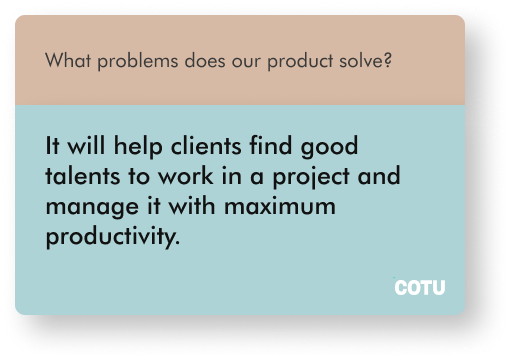
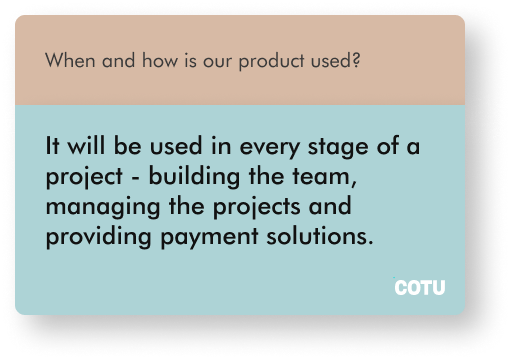
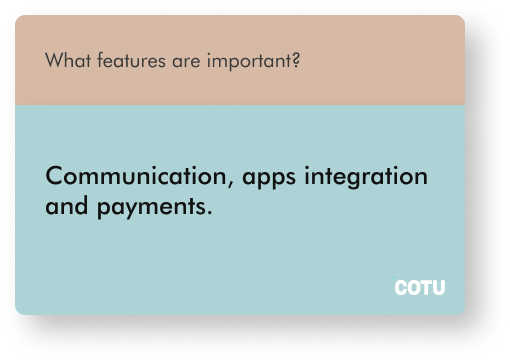
Make
MID-FIDELITY PROTOTYPE
We created wireframes and a mid-fidelity prototype for essential parts of the user journey to ensure our design was on the right track. Building mid-fidelity prototypes balances low and high-fidelity designs, enabling us to gather feedback on the overall user experience without getting diverted by details. It also allows us to make quick changes and adjustments before moving on to the more time-consuming and expensive high-fidelity prototype stage. It allowed us to test and validate our design decisions and incorporate any valuable feedback into future rounds of development.
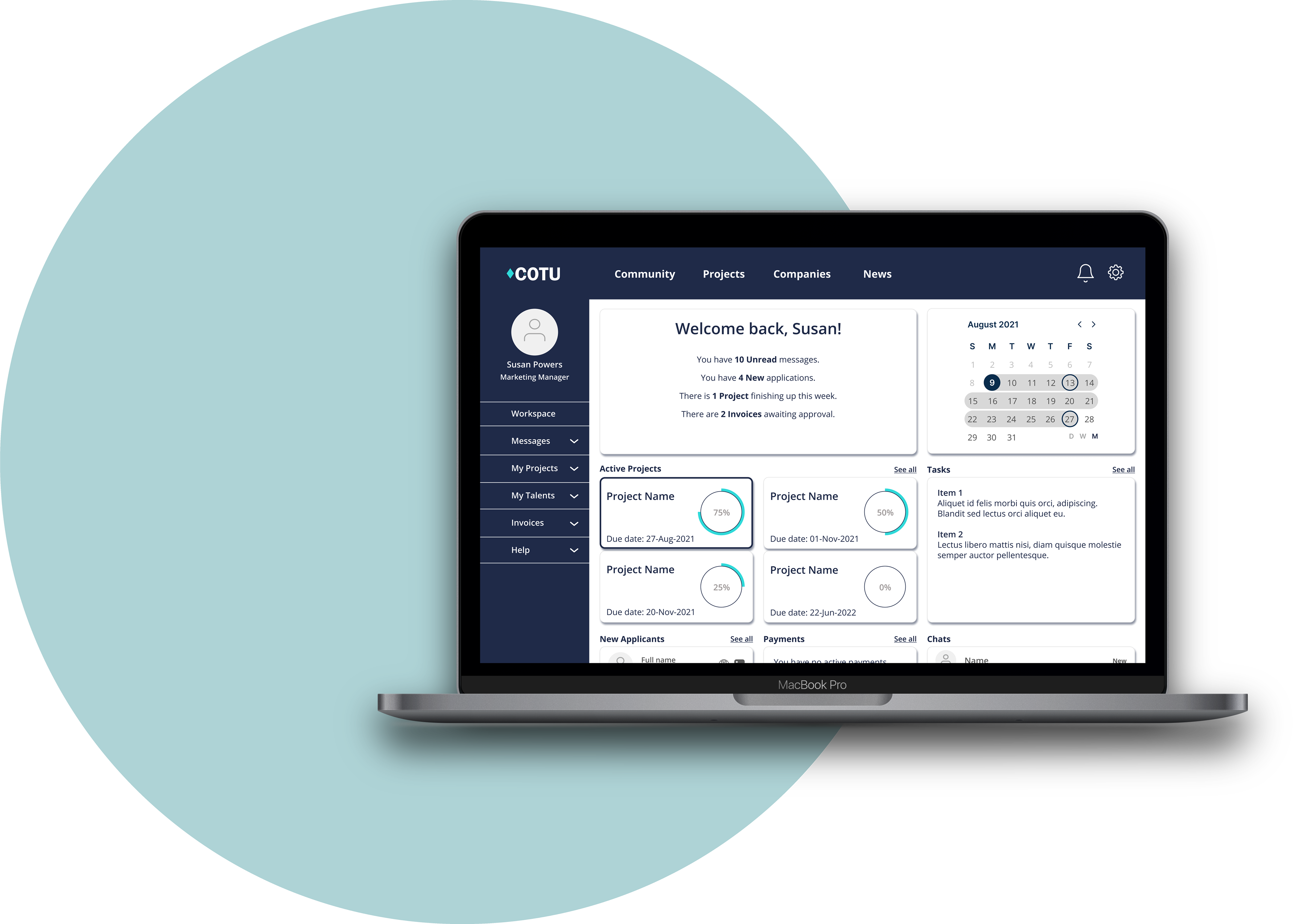
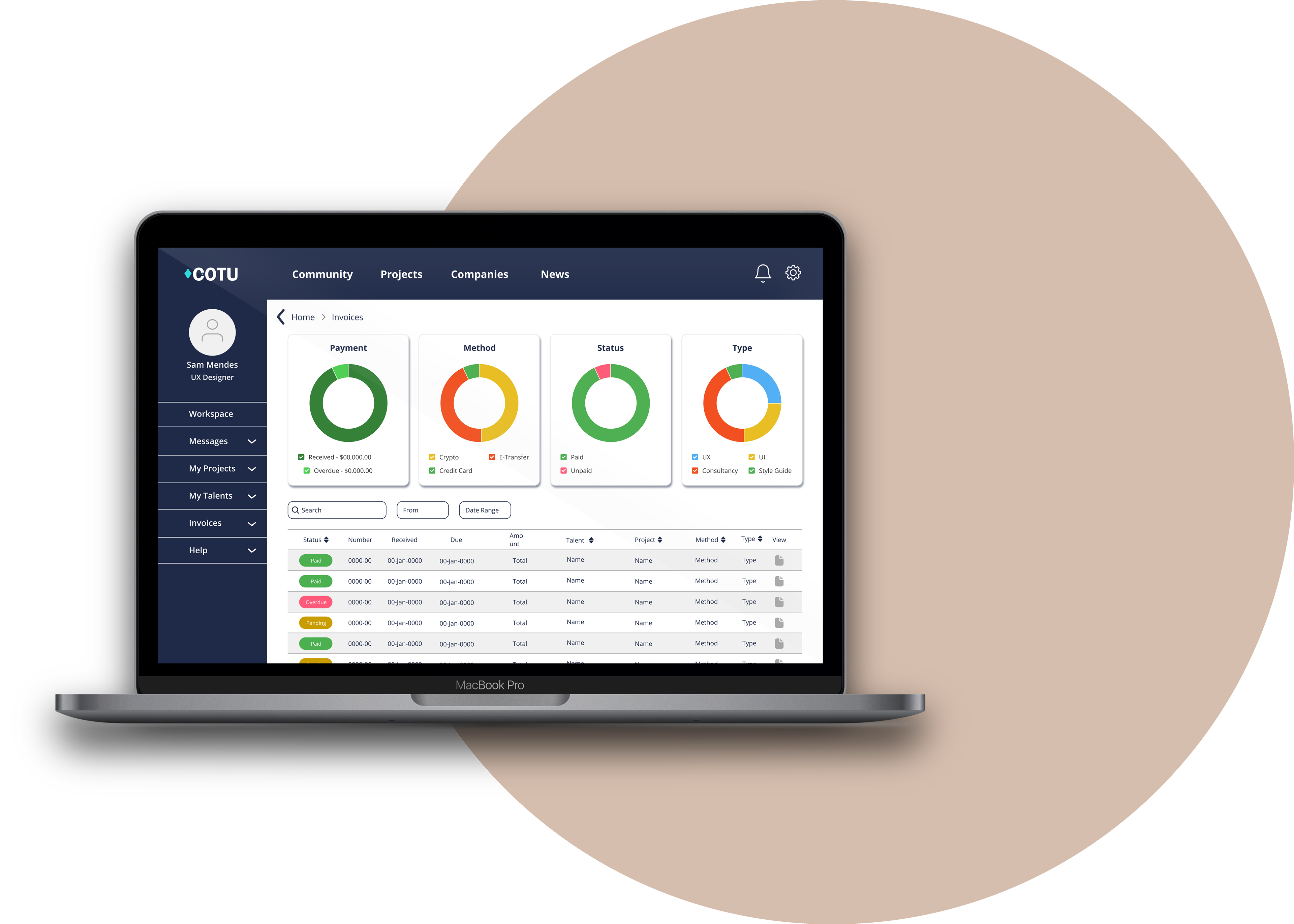
Check
WHAT USERS REALLY THINK OF COTU
To ensure we were on track with our goals, we conducted usability tests to evaluate our hypothesis and determine whether we had achieved the desired outcomes. Our primary objective was to assess user navigation and integration of remote teams on the platform and identify any challenges users may encounter and what would motivate them to choose COTU over other existing platforms.
Usability testing is a critical component of the UX design process. It allows designers to observe how users interact with a product and identify any pain points or areas for improvement. By conducting usability tests, designers can gain valuable insights into user behaviour and preferences, informing design decisions and ultimately leading to a more user-friendly product.
We found that users could understand the main value proposition of COTU, which is to connect clients with skilled professionals. However, they struggled with the platform's overall usability and needed clarification on some of its features. Users found navigating the platform challenging and needed help finding the information they needed to complete their tasks. Additionally, many participants reported needing more engagement and motivation to continue using it. These insights were crucial in informing our design decisions and identifying areas where we needed improvements to enhance the user experience.
The Next Steps
THE PATHWAY TO SUCCESS
FEATURE PRIORITISATION
We helped COTU identify the most critical areas for development to achieve the greatest return on investment using a features prioritisation matrix. It's a data-driven decision tool that provides a structured and objective way to evaluate and prioritise features based on their importance to the user and their impact on the product.
Creating a job board and talent pool were easy and cost-effective features. Additionally, making the website mobile responsive and adding a simple chat function could be a good starting point for COTU. However, it was crucial not to distract from the primary functionality of the platform by prioritising secondary features.
ASSUMPTIONS VS OUTCOMES
It is essential to focus on the outcomes of the product and how it would benefit users to improve the design process of COTU. While we have laid the groundwork based on our current knowledge, relying solely on assumptions can be risky and lead to incorrect decisions.
Therefore, obtaining feedback on any changes made to the platform is crucial, even if they involve some risk. This feedback can provide valuable insights to improve the platform's design process.
TEST, LEARN & RESEARCH
To gain insights into how users interact with the product, COTU must take a step back and conduct comprehensive research. This systematic approach involves gathering feedback from potential users to ensure that development efforts are on the right track.
By focusing on the users' needs and preferences, COTU can better understand how its product will impact its target audience. This approach allows for a more user-centred design, resulting in a product that meets users' needs and is more likely to be successful. Rather than solely focusing on the end product, COTU should prioritise understanding its users and how its development can best serve them.
FINAL CONSIDERATIONS
For COTU to succeed, it is essential to consider how its customers will use and integrate the platform with their existing systems, particularly from the Human Resources and Financial perspectives. As both clients and talents are part of the same ecosystem, it is crucial to understand their needs and ensure the platform serves them equally.
However, the client's side is the platform's backbone, and COTU must focus on solving at least one of the challenges the creative communications industry faces to move forward. By addressing the industry's problems, COTU can establish itself as a valuable and reliable solution, leading to increased user adoption and success.
Looking Ahead
WHAT DID I LEARN?
Working on this project was an exciting opportunity to apply all the skills and knowledge I had acquired during the previous months of training. At first, I must admit I felt lost because the client had yet to develop a concrete product; they only had a few scattered ideas and sparse information. However, as I delved deeper into the project, I began to understand that what the client wants is not always what they truly need.
You can create a more effective and successful product by balancing your professional expertise and your client's vision. As a UX designer with a substantial background in Architecture, trusting your instincts and challenging the brief when necessary is crucial. However, it is equally important to keep the client in the loop throughout the process and maintain open lines of communication.
One of the most important lessons I learned from this project is that the kick-off phase is not necessarily the beginning of the design process. It can be the middle or end of a project's evolution. Just like living organisms, projects are dynamic and constantly evolving. The key is to take the first step, start somewhere, and follow a sustainable method. It means following a design process that is replicable and measurable, allowing for adjustments and improvements as needed throughout the project's lifecycle. By following a reliable and consistent design process, you can ensure that your work will yield positive and measurable results for you and your client.
